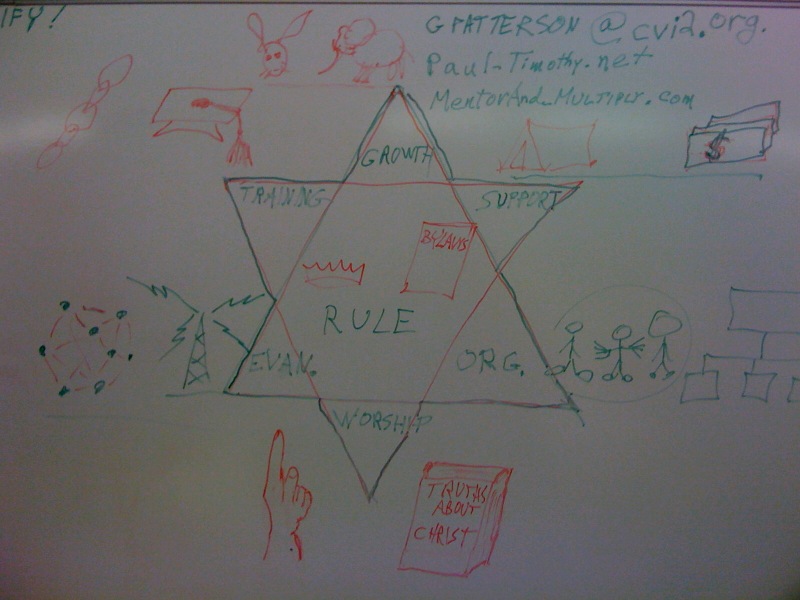PlantR recently hosted two church planting practitioners who have worked all over the world in contributing to church planting movements–George Patterson and Tony Dale. Both contributors enriched our understanding of church planting and movements. This post will focus on Patterson.
Dr. George Patterson is Adjunct Professor of Intercultural Studies at Western Seminary and possesses 35 years of missions experience. At age 76, he is lively, insightful, and pastoral. It was a remarkable privilege to spend time with him. Making light of academics, his stated goal was to “easify church planting.” Patterson’s interactive discussion revolved around a 6 pointed star diagram that depicts seven non-negotiables in church planting movements.
This diagram helpfully brought together the elements of evangelism, worship. organizational structure, financial support, reproducible growth, leadership training all under the rule of Christ. As we worked our way around these points, Patterson provided refreshing, field-based stories and missiological insights. Instead of commenting on each one, I will offer a few of his insights here. We hope to get a U-tube video up soon.
Rabbit and the Elephant
Patterson pointed out there are three main types of churches—rabbits, elephants, and rabi-phants. Rabbit churches are small churches that reproduce quickly. If rabbits were killed as quickly they would quickly outweigh all the elephants in the world. Elephant churches are big churches that have longer gestation periods and reproduce much more slowly, but they are powerful. All too often the rabits and elephants compete instead of partner. A rabiphant church combines elements of a traditional, larger church with smaller missional units of non-tradtional missional churches. He averred that we need all three. This is often not the message we hear from micro/organic/house church voices, so that was refreshing.
Reproducibility
When asked what impedes reproducibility, Patterson offered a variety of insights:
When the sun rises and sets on the pulpit. Quoting from Jonathan Edwards, he remarked: “A churches greatest weakness is invariably its greatest weakness taken to excess.” Pulpit can strangle mission and evangelistic reproducibility.
Pastoral training by apprenticeship not seminary. Noting that this practice has been effective throughout church history. He was quick to point out that seminary is not the problem, but the way students respond to formal education conditions them for churches that are not highly reproducible, low in cost, and missional.
A group small enough to do the one-anothering and fast reproduction is typically too small to be the church. Small groups cannot have all the gifts of Ephesians 4, nor can they sustain reproducibility. Therefore, the small groups need to rely on one another. There need to be strong relationships between small groups and lots of interaction in order to promote healthy, missional churches.

